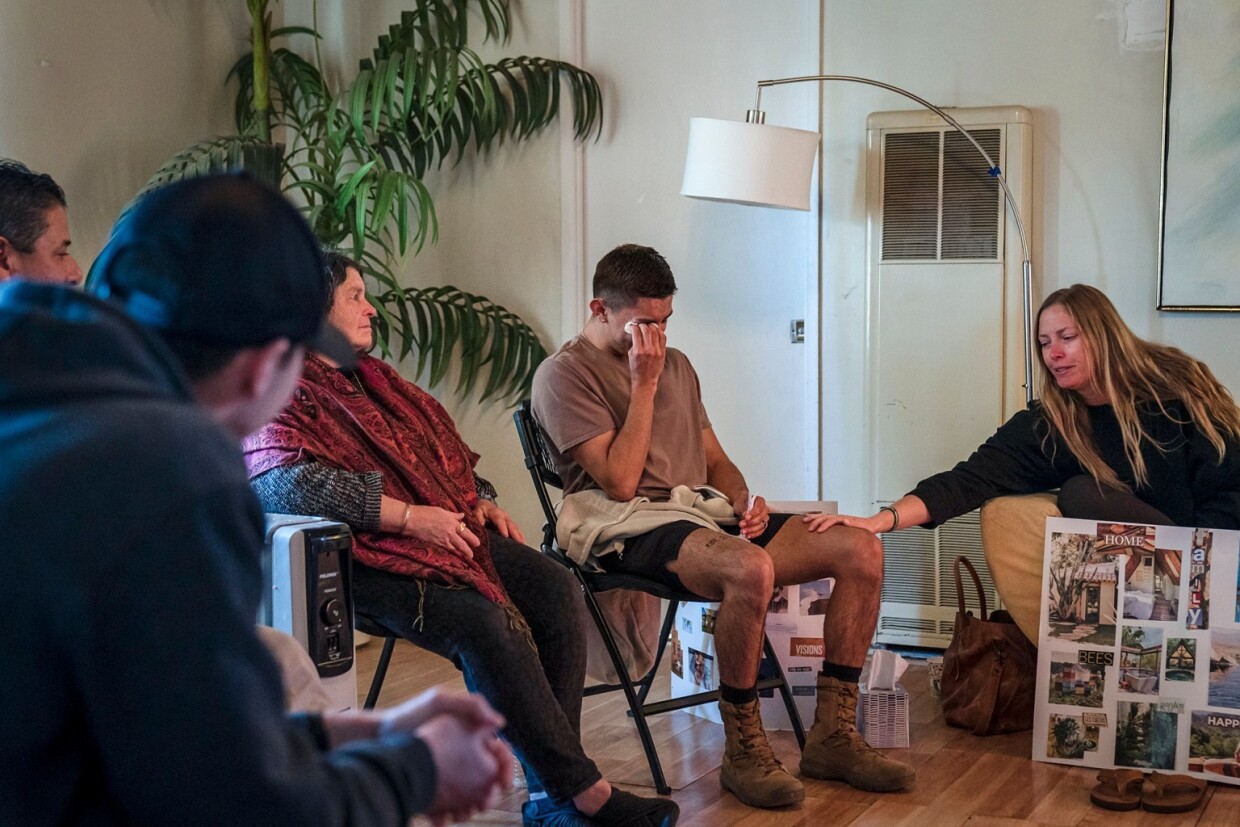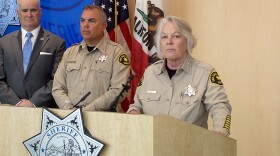The morning sun warms California’s high desert, launching a clear spring day. Behind high walls at The Nurturing Nest, across from a burbling mineral pool, a small group of men and women roll up yoga mats and arrange themselves in a semi-circle. Their week at this tranquil retreat is ending and a counselor seeks final thoughts from each of them.
“Why are you here?” the counselor asks a young woman sitting alone on a small sofa, hugging a pillow to her chest. She stares into the middle distance and lets out a deep breath.
“Death. So many deaths,” she said.
The men and women at the retreat are steeped in death: All but one work for Cal Fire, dispatched to the desert as a last resort, seeking release from the neverending pain and fatigue brought on by their jobs.
Defensive and defiant at the beginning of the week, the California firefighters and a dispatcher break down their emotional walls by the end of it, laughing, weeping and recounting once-secret stories about death, terror and fire. They recall horrific sights of friends trapped by flames and reveal their urges to take their own lives.
If you are having suicidal thoughts, you can get help from the National Suicide Prevention Lifeline at 1 (800) 273-8255 or suicidepreventionlifeline.org
For firefighters battling California wildfires, these emotional injuries are a workplace hazard. Longer and more intense fire seasons have taken a visible toll on the state, leaving a tableau of charred forests and flattened towns. But they’ve also fueled a silent mental health crisis, including an alarming rise in post-traumatic stress disorder among the ranks of Cal Fire, the state’s firefighting service.
Fifty-four California firefighters have died in the line of duty since 2006, according to the Cal Fire Benevolent Foundation, and nationally, more than 3,000 firefighters have died from job-related injuries and illnesses since 1990.
But when they race into wildfires, it’s not just their bodies that are at risk, but their psyches, too. Wildland firefighters arguably face more psychological stress than most, since their battles are prolonged and their personal risks are high.
“I would be willing to bet that there’s suicidal ideation in half of our employees right now, and half of them have a plan to do it,” said Cal Fire Capt. Mike Orton, a former Marine who recently transferred to a Los Angeles County inmate fire camp.
CalMatters interviewed several dozen California firefighters — including many high-ranking battalion chiefs and captains — as well as mental health experts and family members, revealing an expansive and unaddressed problem that suggests a broken and depleted fire service is operating in a state that seems in perpetual combustion.
CalMatters found an expansive, unaddressed problem that suggests a broken, depleted fire service. Long hours and stress may endanger the public, too.
Firefighters, who in the past were stoic and suffered in silence, told CalMatters their emotional and personal stories, revealing their fears that their lack of sleep, long hours and stress could lead to poor decisions on the fire lines — which would endanger not just their crews, but the public, too, as California’s wildfires intensify.
California’s wildfire statistics read like the losing side of an arms race: 2020 was the state’s worst fire season on record, with more than 8,600 blazes taking 33 lives and burning 4% of the state. Once-feared megafires are now dwarfed by the state’s million-acre “gigafires.” Climate change has forced wildland firefighters, trained to be nimble problem-solvers, to do a hard pivot. With too few firefighters to cover all the fires, they are on the front lines longer, with shorter respites at home. Some battle fires for months at a time.

The state’s much-admired fire service has only recently tried to come to grips with the scope of the mental health problems among its 6,500 firefighters and support personnel. Cal Fire’s behavioral health program began in 1999 but four years ago had only eight employees, reaching 27 now. Their work is mostly reactive — sending those who actively seek help for their pain, trauma and suicidal thoughts to retreats or therapists under contract with the state.
Fatigued, traumatized and frustrated, some California firefighters, including captains and battalion chiefs, say Cal Fire must do more: Staffing shortages create punishing shifts, forced overtime and long deployments. Cal Fire keeps crews on fires for 21 days without respite, while their counterparts with the federal government work 14-day shifts. Those deployments frequently go much longer.
Many suffering from PTSD recount troubles receiving benefits and health care coverage under the state’s workers’ comp system. And some say family members cannot collect survivors’ benefits for a firefighter’s suicide because it’s not classified as a line-of-duty death.
The job strains their marriages and families. One Cal Fire battalion chief in Riverside County, Jeff Burrow, said 80% of his station house crew got divorced in a single year. Sleep deprivation, and alcohol and drug abuse are on the rise, firefighters and therapists said.
Many fire station leaders around the state told CalMatters they see an unaddressed epidemic of PTSD and suicidal thoughts among their crews. Yet CalFire does not collect any data on suicide or PTSD within its ranks.
“There’s a lot of people here hurting,” said Tony Martinez, a 29-year veteran Cal Fire captain in Napa County. “It’s an absolute epidemic, it’s not a cliché…The last several years, I’ve had so many coworkers either kill themselves or attempt to kill themselves — in some cases, multiple times.”
Martinez said he “didn’t know it was possible to have PTSD in the fire service. It wasn’t a word that we knew of.” He said he “never saw” PTSD among his colleagues in his first 20 years as a firefighter but he now realizes many of the older veterans’ erratic behavior was the result of years of trauma. “When I reflect back, I think they had PTSD. I think people forever have been suffering in silence.”
“It’s an absolute epidemic … I’ve had so many coworkers either kill themselves or attempt to kill themselves — in some cases, multiple times.”— Cal Fire Capt. Tony Martinez
Resources Secretary Wade Crowfoot, whose agency oversees Cal Fire, called the mental health of California’s firefighters “a growing challenge. At times it feels like a crisis.”
“We are asking firefighters to fight what are truly catastrophic wildfires,” Crowfoot said. “Every year we are sending thousands of firefighters into intensifying conditions, and more and more dangerous seasons.”
But who will want to battle these fires if these conditions continue?
Several firefighters described high turnover at their stations. And Cal Fire’s statistics suggest that attrition has suddenly worsened: Last year, the number of firefighters and other full-time personnel voluntarily leaving was nearly twice the four-year average, reaching 691 — more than 10% of the agency’s workforce, according to data provided by Cal Fire spokesperson Chris Amestoy.
Martinez said he “bleeds Cal Fire,” but neither of his young adult sons want to follow him into the fire service, and he understands. “I tell my young firefighters: ‘Don’t work here,’ ” he said.
Statistics gauging the extent of the department’s mental health problem are scant: Cal Fire collects no information on PTSD or suicide among its staff so the agency cannot say whether it’s as rampant as firefighters say.
Cal Fire does track the number of times its employees and family members contact a peer-support team for help with an array of issues, primarily physical and mental health. And those numbers have been climbing: from 1,362 contacts in 2011, the first-year Cal Fire began compiling the data, to 17,310 last year.
Counselors say a majority of the requests for help are related to stress. So far this year, 24% sought referrals for medical and psychological issues, 12% for grief and loss and about 9% for addiction or substance abuse.
A 2016 report found that nationwide, firefighters are 40% more likely to take their own lives than the general population. In addition, in a 2019 online survey of more than 2,600 wildland firefighters, about a third reported experiencing suicidal thoughts and nearly 40% said they had colleagues who had committed suicide. Many also reported persistent depression and anxiety.
The survey is believed to be the most extensive research into the mental health of wildland firefighters.
Patricia O’Brien, a former federal firefighter who co-authored the study, said the increasing frequency and intensity of California wildfires, coupled with the fire-service ethos of stoicism, is a formula for severe and unresolved trauma.
“This is humans battling a force of nature. We don’t get to conquer nature,” she said. “And if we try to do that, there will likely be negative outcomes in the form of trauma exposure, tragedy and loss. There are human burdens that firefighters carry.”
California’s firefighters carry a heavier burden than most. Unlike the majority of the nation’s wildland firefighters, Cal Fire crews are required to be ambidextrous: They staff local fire agencies in 36 of California’s 58 counties, meaning they toggle from responding to wildfires to hazardous material spills, swift-water rescues, train crashes and medical emergencies.
“We are humans first, not firefighters or dispatchers,” said Ali Wiseman, a Cal Fire dispatcher who reeled off a cascade of colleagues’ deaths while attending the recent trauma camp in the desert. “Even though it’s hard or painful and embarrassing, I have to trust the world and tell my story.”
Now a year-round, neverending battle
All that the fire service once understood about fire size, behavior and severity is no longer valid. “Once-in-a-career” fires now come every year. What used to be called a fire season is now a year-round battle in California, with about 8,800 wildfires last year alone. Firefighters are staying on the fires lines much longer as they battle larger, more intense and more persistent fires.
In recent years, fire scientists watched as back-to-back fires did the unthinkable, burning across the Sierra Nevada’s granite wall. Lightning sieges sparked fires where flames had seldom been seen, in the North Coast’s “asbestos forests,” dubbed that because they used to be virtually fireproof.
Three major wildfires illustrate the challenges that California's wildland firefighters face as the climate heats up and the drought drags on.
Two were caused by PG&E equipment, the third by lightning. Together, they damaged or destroyed more than 20,000 buildings. Eighty-five people were killed.
Last July, the Dixie Fire ballooned into the second-largest fire in recent history. It burned about 960,000 acres, which is more than three times the size of San Francisco.
It was literally visible from space. This photograph was taken by an astronaut aboard the International Space Station.
The fire destroyed more than 1,300 buildings, including nearly the entire town of Greenville, California.
Late fall isn’t generally considered part of California’s fire season. Since records started, only 4% or so of fires have started in November or December.
But in November 2018 the Camp Fire, the second fire we are examining, ignited because of equipment owned by PG&E.
The Camp Fire wasn't the biggest fire by acres. It was not even the biggest that year.
But it remains the deadliest in the state’s history, killing 85 people.
It also burned a third of all the structures damaged or destroyed by California wildfires since 2008 — more than 18,000 buildings.
In August 2020, lightning struck California more than 12,000 times during a tropical storm, which created more than 500 fires.
37 of those combined to become the August Complex, the third fire we are examining.
The complex, which is a collection of fires that have merged, burned more than 1 million acres, making it the largest in recent history. Put another way, 1% of the entire landmass of California burned in the August Complex.
By October, nearly the entire state was living beneath a smoky sky.
And it's only getting worse.
California’s wildland firefighters are now in a defensive crouch, facing an amped-up enemy fueled by climate change’s most destructive weapons: the worst drought to grip the Southwest in 1,200 years, loss of 130 million parched trees from disease and pests, and extreme weather conditions that defy predictability and precedent.
And there is little indication that things will get better as California cycles into an era of what fire crews call drought fires — massive, stubborn and dangerous. Wildland fire commanders caution their charges to “keep their heads on a swivel” — always alert to danger. Mental health experts now add another layer to that vigil: Firefighters must also be on the lookout for stress, fatigue and trauma in themselves and their colleagues. It’s tricky, however, to spot.
For some, PTSD can be caused by a single horrific event. For others, it’s a career’s-worth of awfulness that finally becomes too much.
“It’s all cumulative,” said Jeff Griffith, a Cal Fire captain who retired in December after 30 years on the job. “It’s a bucket, and there’s a drop, drop, drop. Eventually, your bucket is going to overflow.”
Griffith said the personality type of firefighters is to “walk it off then get back to work. The sense is that you can’t go to your crew and confess a weakness because you are the officer. We’ve got hotlines where people are talking about substance abuse and marital abuse. People are overdosing on their day off.”
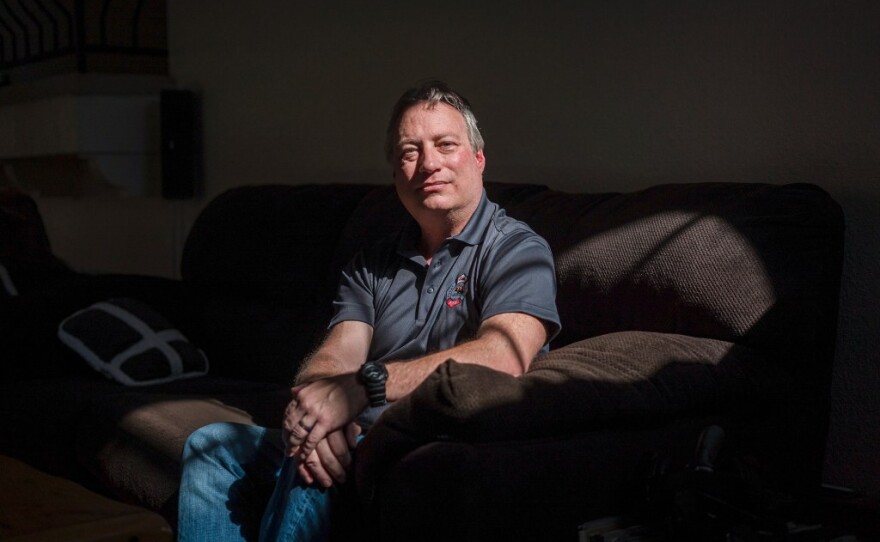
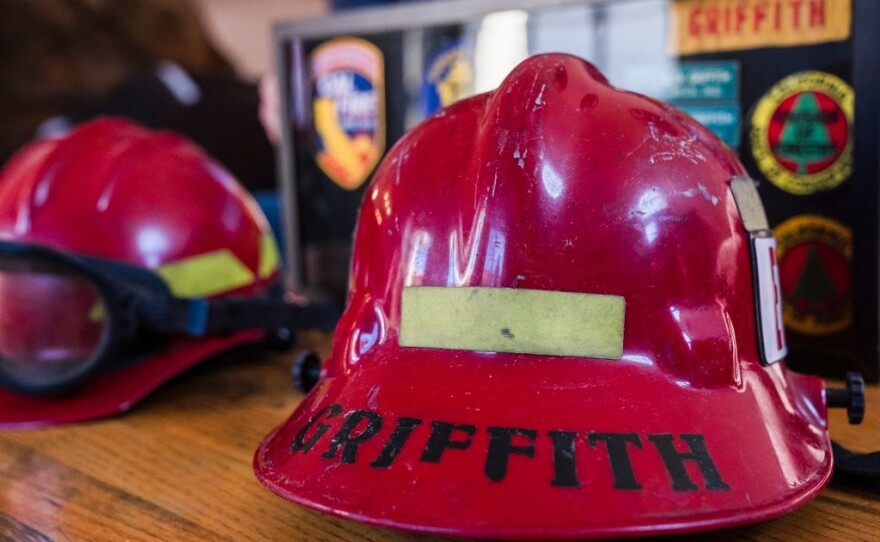
One reason that mental health data is hard to come by for California’s wildland firefighters is they have “a work culture in which people are being paid to be tough and show no weakness,” said Sidra Goldman-Mellor, an associate professor of public health at University of California, Merced, whose work as a psychiatric epidemiologist focuses on tracking depression and suicide.
“People are much less likely to volunteer information about their mental health problems,” she said. “It’s very different to how we talk about physical health problems. In large part, it’s the stigma. In many cases, though, people don’t recognize their depression and PTSD as a psychiatric problem.”
Cal Fire’s mental health program, Employee Support Services, functions as triage, working with those who want help, then directing them to therapists or doctors. Mike Ming, a 30-year Cal Fire veteran in charge of behavioral health and wellness, said much of the work is done by peers who are “active listeners.” The counseling and other services are voluntary and confidential.
“We ask the question, ‘Are you going to kill yourself?’,” Ming said, adding that if a firefighter says he or she is considering suicide, the peer counselor immediately contacts authorities. “We are never going to leave them alone in that case. We stay with them.”
Ming said firefighter suicides are a “trend that we’re hearing about more. We’ve had six deaths over the last couple of weeks. There have been overdoses. There’s no getting around that in the first-responder world, there is a problem with suicide. Cal Fire is no different.”
Trauma is “all cumulative. It’s a bucket and there’s a drop, drop, drop. Eventually, your bucket is going to overflow.”— Jeff Griffith, retired Cal Fire captain
While peer programs can be useful in reaching those reluctant to talk about private matters with strangers, Goldman-Mellor said it’s difficult to measure their effectiveness if the fire service doesn’t collect data on suicides and PTSD.
“In general there are very few programs out there that have empirically been shown to reduce suicide rates,” she said. “Even if a program does work, you may not have the numbers. You can’t claim that it’s effective to reduce suicide if you are not tracking that outcome.”
Another problem is lack of expertise in diagnosing unseen wounds — not broken bones but broken minds. “It’s very, very, very difficult to diagnose PTSD,” Goldman-Mellor said. “Many physicians are not trained in evaluating mental health problems.”
Mynda Ohs is a trauma counselor based in San Bernardino who specializes in treating first responders — both her husband and son are wildland firefighters. She said it’s common for firefighters to mask their stress or trauma by binge drinking or taking illegal drugs.
“The most prominent thing I see is anxiety,” she said. “First responders can become accidental alcoholics, looking to take that edge off quickly. They are looking for calm. I see a lot of porn addiction — it’s legal and it does serve as an outlet or release. I have five right now that I am trying to help.”
Feeling better, feeling lighter
Back at Nurturing Nest — the rambling spa retreat in Desert Hot Springs that usually caters to a self-help, spiritually inquisitive crowd, mats are rolled out, and firefighters gingerly work through yoga positions in a sunny room.
On weeks when the facility is given over to firefighters, its name is toughened up to Freedom Ranch. Some firefighters, dubious about the need for therapy, call the trauma retreats “Camp Snoopy.”
Cal Fire sends more than a dozen firefighters each month for intensive treatment at these workshops, with sessions involving vision boards, yoga and mindful breathing lessons.
Those who come to the retreat do so of their own volition. No one is ordered to attend. For some, it took years to gather the courage to face their demons.
Steve Diaz is quietly observing from a corner. He retired as a battalion chief after 34 years with Cal Fire, the last few years as part of the peer-support program. He knows six colleagues who killed themselves. “I believe it is a crisis,” he said. “One is too many.”
"I had hit rock bottom....I've seen a lot of deaths. I've seen a lot of suicide with my peers."— Hiram Vazquez, Cal Fire captain based in Riverside
Ramesh Gune runs the facility and is a therapist trained to work with first responders. He’s drained at the end of a week of concentrated counseling as if he’s taken on the trauma of his charges as they slough off their emotional injuries. He speaks softly, gesticulating with his slender hands.
“Mostly anger, that is what I see a lot,” he said. “ ‘I am not what I pretend to be,’ that’s the conflict. ‘I feel helpless.’ That sense of helplessness drives them crazy. They cannot save people. ‘I am not enough.’ They harbor that negative feeling constantly. They become paralyzed.”
His work, he said, begins with reminding California’s firefighters that there is a path to feeling better, feeling lighter.
Hiram Vazquez, 38, carries a body full of tattoos as visual prompts lest he forgets what’s important to him — portraits of his family on one muscular arm and a pirate theme on the other to remind him of the storms he’s weathered. The Cal Fire captain based in Riverside is trying to focus on the good things, incorporating coping tools he learned at the retreat.
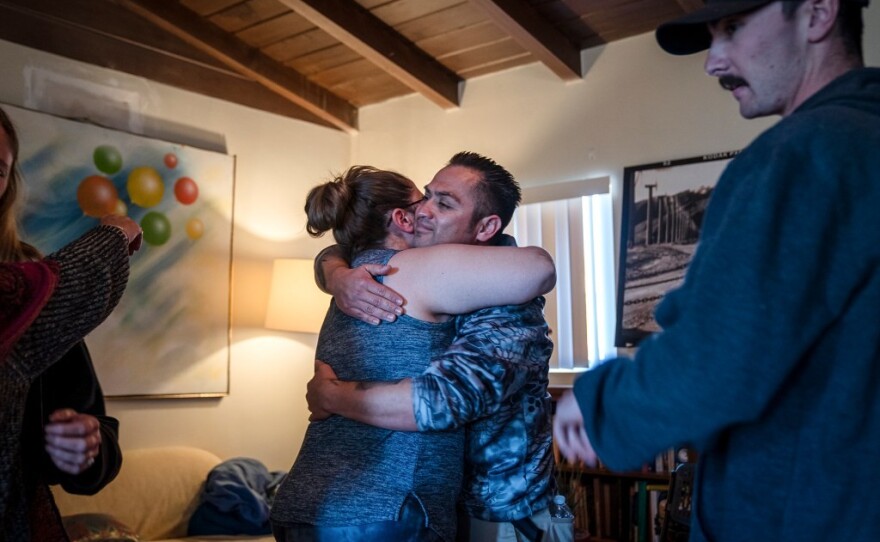
“I came here pretty broken. A broken family, broken life. A lot of grief,” he said. He twice planned his suicide. He bought life insurance and planned to shoot himself, but rethought that when he realized his family wouldn’t be able to collect on the policy until it had been in place for two years. “And I didn’t want my kids to clean up after me,” Vazquez said.
Plan B was to speed along Highway 74, running through a guardrail and staging the scene to make it look like a car accident.
“I had hit rock bottom,” Vazquez said. He finally asked for help, and came to the desert.
“Stuff I didn’t realize I was carrying came up,” he said. “I’ve been on incidents where my friends have got burned over. I’ve been on incidents where people I was working close to have died. I’ve lost good friends. I’ve seen a lot of deaths. I’ve seen a lot of suicide with my peers or people that I know.”
Some of the trauma came from witnessing the trauma of others. Vazquez was in charge of an engine on the 2007 Harris Fire, which killed eight people in San Diego County. Another engine was caught in the fire, trapping firefighters.
“I was listening to the radio traffic, and one firefighter was screaming for help,” he said. “I was listening to air attack talking to the battalion chief who’s trying to find those guys, and he’s guiding them into this site, then telling them to back out because it’s about to get burned as well.”
As he recounts the story in a group session, other firefighters nod in recognition and understanding. No judgment.
“I feel free,” Vazquez said. “I feel like I don’t have to carry that burden anymore. Now I find I can live free.”
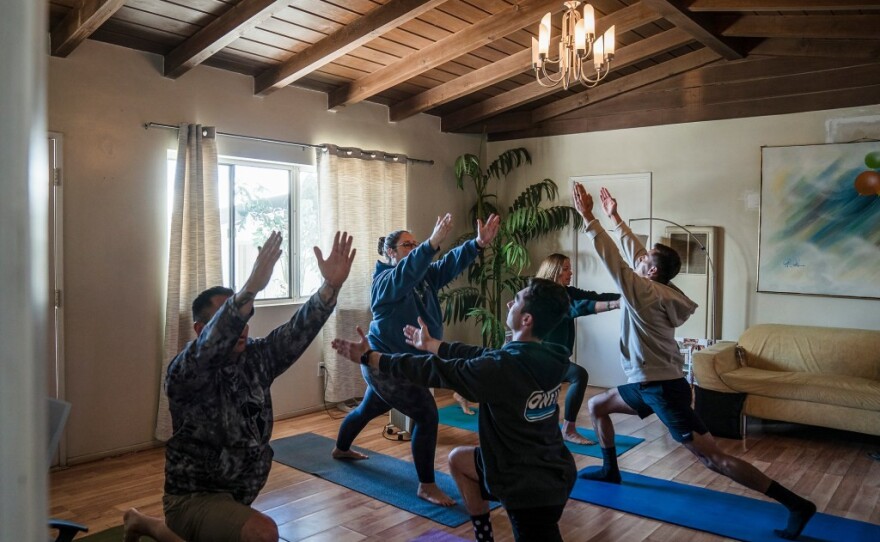
The responsibility of leading crews, and keeping them safe, weighs heavily. It’s one of the burdens that brought Orton, 47, the former Marine now stationed at a Los Angeles County inmate fire camp, to a trauma retreat.
“Every action I take (as) captain, every day of my career, I always think, ‘How am I not going to die? How am I not going to kill somebody today?’ You are constantly thinking about that on the job. I compartmentalize things so that I am able to take the stress.”
Compartmentalizing — putting negative thoughts and upsetting experiences in a mental lockbox — is an expedient way of stowing trauma, getting it out of the way so that memories don’t become incapacitating.
But even well-secured boxes can spring open.
That’s what happened to Orton on the last day of a retreat. He abruptly shared a long-buried personal trauma — the emergency stillbirth of his son 18 years earlier. Gune gently guided Orton through an exercise in which Orton could cast away his pain by visualizing the event and speaking to his lost son, saying the goodbye he was unable to express at the time.
Gune asked Orton to see in his mind’s eye his baby with angels on his shoulders. Then, as a group, the other firefighters joined Orton as they escorted the baby boy — borne aloft by angels’ wings — out of the room and away up into the bright blue sky.
The men stood in the doorway with arms slung around each other’s shoulders, looking up and feeling the weight slip away.
Data analysis and visualizations by Jeremia Kimelman, Erica Yee and John D’Agostino.

